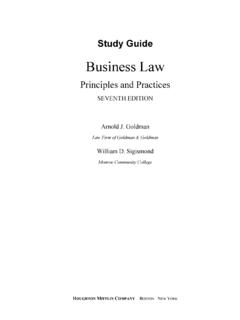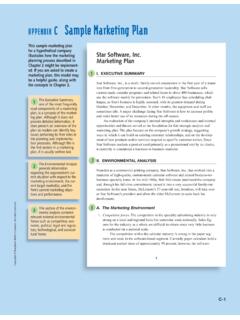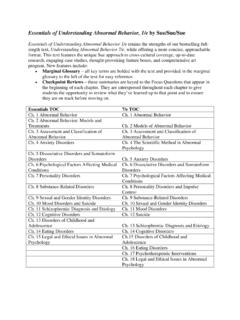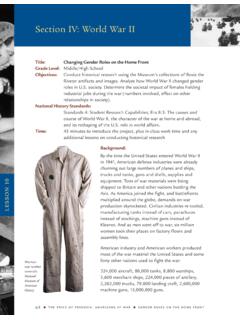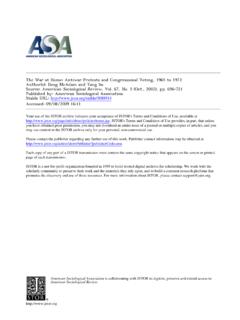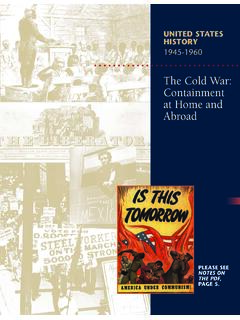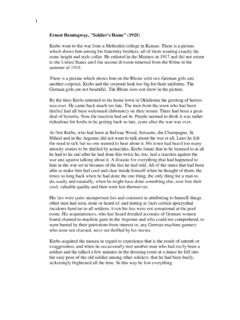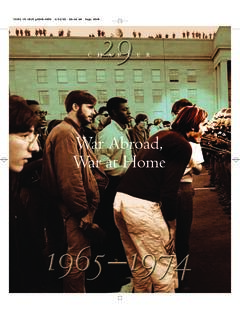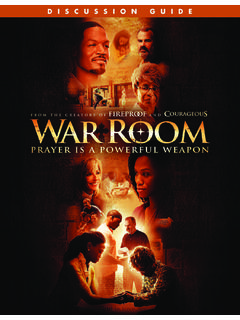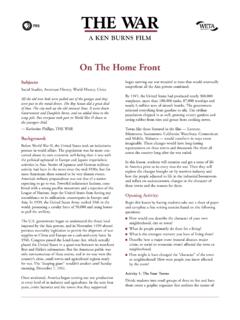Transcription of The Second World War at Home and Abroad, 1941–1945
1 Copyright Houghton Mifflin Company. All rights reserved. CHAPTER 27 The Second World War at home and Abroad, 1941 1945 LEARNING OBJECTIVES After you have studied Chapter 27 in your textbook and worked through this study guide chapter, you should be able to: 1. Discuss United States military strategy and the major military operations in the Pacific theater that brought America to the verge of victory by 1945. 2. Describe the military strategy and the major military operations undertaken by the Allies in the European theater; discuss the disagreements that arose concerning strategy; and explain the resolution of these disagreements. 3. Examine the impact of the Second World War on American businesses, institutions of higher learning, organized labor, and the federal government, and discuss and assess the role played by the federal government in the war effort.
2 4. Discuss the impact of the Second World War on American civilians in general and on African Americans, Mexican Americans, women, and American families specifically. 5. Examine the tensions between America s democratic ideals and its wartime practices, and discuss specifically the civil liberties record of the United States government during the Second World War with regard to Japanese Americans, African Americans, and the plight of Jewish refugees. 6. Discuss the impact of military life and wartime experiences on the men and women in the United States armed forces during the Second World War. 7. Examine the relations, the issues debated, and the agreements reached among the Allies from the Second -front controversy through the Yalta and Potsdam conferences, and discuss the issues left unresolved after Yalta and Potsdam.
3 8. Explain and evaluate President Truman s decision to use the atomic bomb. 9. Assess the impact of the Second World War on the World community of nations and on the World balance of power. THEMATIC GUIDE In Chapter 27, as in Chapters 23 through 25, we look at the changes begot by war. Having dealt with changes fostered by the First World War, Americans entered into an era of normalcy during the 1920s. Yet even in the midst of the peace and prosperity of the 1920s, Americans often seemed to be fighting a cultural war that pitted those who adhered to older traditional values and beliefs against those who accepted the new values of the era. It was during the Jazz Age that America continued its transition from an agricultural to an industrial nation, women made strides in breaking out of their constraints, and African Americans became more outspoken in their demand for equality.
4 Furthermore, Chapter 27: The Second World War at home and Abroad, 1941 1945 327 Copyright Houghton Mifflin Company. All rights reserved. the new openness about sex and the challenges of science to fundamentalist religious beliefs during the 1920s caused anxiety in many quarters. Then came the economic disasters of the Great Depression. The collapse of the nation s economic system led to the election of Franklin Roosevelt and to the mobilization of the federal government in a war against joblessness, poverty, and homelessness. The Roosevelt revolution forever changed the relationship between the American people and their government. Then, after the Japanese attack on Pearl Harbor on December 7, 1941, Americans had to face the anxiety of change within a nation whose very survival depended on successful mobilization for war.
5 Since this was total war, not only did troops have to be mobilized, but the homefront had to be mobilized as well to produce the materiel necessary to defeat Japan and the Axis Powers. In the first section of Chapter 27, The United States at War, we look at the earliest stage of the Second World War in both the Pacific and European theaters. In the Pacific, America was largely on its own to fight the Japanese; and, after initial losses, successfully broke the momentum of Japan s offensive at the Battle of Midway. In turning to the European theater we look at America s Europe First strategy and at the undercurrent of suspicion among the Allies, obvious in the Second -front controversy.
6 In November 1942 American and British forces landed in North Africa and were eventually successful in defeating General Erwin Rommel and his Afrika Korps. Back in Europe, the Soviet army s successful defense of Stalingrad proved to be a turning point in the European war. The focus of the chapter then shifts to a discussion of the nation s mobilization for war on the production front. This mobilization brought (l) renewed government-business cooperation and an acceleration of corporate growth, (2) the growth of scientific research facilities through government incentives, (3) new economic opportunities for African Americans, Mexicans, and women, (4) the growth of labor unions, and (5) the successful conversion of American factories from civilian production to military production.
7 The Second World War, to an even greater extent than the First World War, was a total war, requiring not only military mobilization but mobilization of the civilian population as well. As civilian workers poured into the nation s defense plants, the primary responsibility for coordinating total mobilization of the home front fell on the federal government. Therefore, the federal bureaucracy mushroomed in size as one can see in the coordinating efforts of the War Production Board, the Office of Price Administration, and the Office of War Information. Furthermore, the government relied primarily on deficit spending to finance the war. This massive influx of money into the economic system brought full employment and prosperity.
8 As more Americans than ever before moved to take advantage of the opportunities afforded by wartime prosperity, communities changed and conflict emerged between war workers and native citizens. Although the war provided opportunities for African Americans, the Detroit riot of 1943 made clear that racism remained a shaping force in blacks lives. The zoot-suit riot in Los Angeles in 1943 demonstrated that the same was true for Mexican Americans. For women, the war became a turning point. More women, including more married women and mothers, entered the labor force than ever before. As some of the negative attitudes toward women working in heavy industry began to change, women experienced more geographic and occupational mobility.
9 Although they continued to receive lower pay than men and were still concentrated in sex-segregated occupations, more women than ever were deciding to remain in the labor market. But even with those changes, home and family responsibilities continued to fall on their shoulders. In many cases, the wartime absence of husbands and fathers made women fully responsible for the family. The combination of these factors and experiences meant that many women gained a new sense of independence. In The Limits of American Ideals we discuss three significant examples of America s failure to live up to its ideals. While the authors state that, for the most part, America handled the issue of civil liberties well, it is obvious that the treatment of Japanese Americans was an enormous exception to the nation s generally creditable wartime civil liberties record.
10 Forcibly removed from the West Coast, 328 Chapter 27: The Second World War at home and Abroad, 1941 1945 Copyright Houghton Mifflin Company. All rights reserved. Japanese Americans were transported to relocation centers and interned chiefly because of their ethnic origin. As a result, many felt betrayed by their government. There was also the paradox of African American soldiers fighting in a segregated American military against racist Nazi ideology. Furthermore, African Americans on the home front continued to face political, social, and economic discrimination. As in the First World War, African Americans saw the war as an opportunity to achieve their goal of equality in American society.




